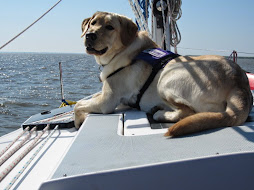Did you know that there is an entire week devoted to
assistance dogs? International Assistance Dog Week is coming up on August 5-11.
We’re planning to share lots of great stories and photos with you about service
dogs changing lives.
Service dogs bond with their partners, and they often know
exactly what their partners need, the way SSD Thunder has bonded with his
partner Justin. “Thunder is so in tune with Justin’s emotions. The bond is
phenomenal, one I will never understand. His mere presence has a calming effect
on Justin,” says Justin’s mom, Laurie.
Justin’s parents decided to apply for a service dog after
they saw what a positive effect SSD Scarlet, one of our facility dogs, had on
him. During the 2009-2010 school year, Justin had a difficult time, escaping
off of school property the first week of school and having violent outbursts.
Although the school district did a wonderful job, Justin’s safety and the
safety of others was becoming an issue. That January, his parents kept him home
until they could find a safe place for him to go to school.
That’s when they found the Capital Area Partial Program
(CAPP), a program that provides professional therapeutic services to children
and families. Justin’s parents were apprehensive about sending him to CAPP, but
they knew he would be safe there. His mom knew they had found a good place for
him when she picked him up on his first day of school. Justin came walking out
of the building with a huge smile on his face, SSD Scarlet at his side.
As Justin’s parents attended monthly meetings at the school,
it became apparent that Scarlet was having a positive effect on him. However,
they still worried that Justin would never be able to live a “normal” life. At
a loss, they decided to look into getting him a service dog of his own.
And that’s when Justin’s life began to change. They went
through the application process – meeting with SSD Gideon and SSD Terra in the
initial interview, and going through three therapy visits with SSD November –
and in September 2010, they got the call to come to Meet the Dogs.
At Meet the Dogs, Justin had the chance to meet and interact
with several dogs in advanced training. But something happened when he met SSD
Thunder. “I knew instantly that Justin would be matched with Thunder,” said
Laurie. In November, Justin was officially matched with a dog, and at Team
Training in February, the dog that trotted over to him was indeed Thunder.
Team Training is exhausting because partners and their
families are trying to learn everything they can about working with their new
service dog in two and a half weeks. Four days into Team Training, Justin took
Thunder home for the first time, and life has never been the same.
“The first night changed our lives, and we never looked
back,” said Laurie. “Justin had never slept through the night before, but that
first night, he took Thunder to bed, and that was it!”
Justin and Thunder are a perfect match. Thunder always wants
to know where Justin is. If Justin is outside playing with the neighbors,
Thunder sits in the yard or window and watches, his tail wagging. When Justin
is having a good day, Thunder is always ready to play. When he is having a bad
day, Thunder is willing to just hang out with him. Justin depends on Thunder
when he is upset, always wanting to snuggle with him. “They’re like two peas in
a pod,” said Laurie.
“We now know that Justin can take on the world. I have a
sense of security. Finally, he is just a boy, not a boy with issues. I don’t
even remember what life was like without Thunder. And I don’t want to,” said
Laurie. “SSD made our dreams come true, believing in Justin. The love and
support we have received is truly a gift I will treasure.”
































